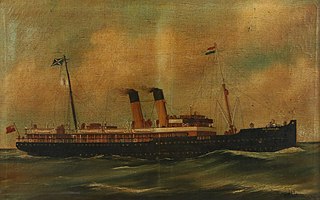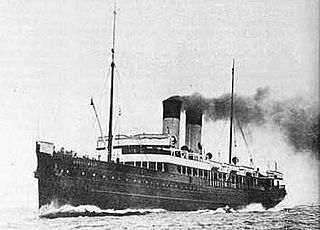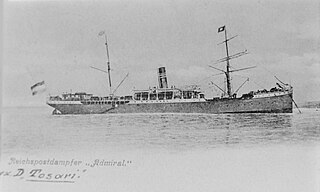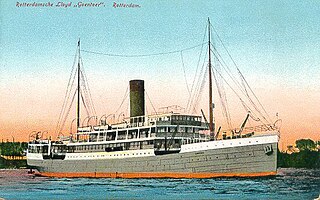
SS Newfoundland was a wooden-hulled brigantine and steamship that was built in 1872 and wrecked in 1916. She was a cargo ship, and for part of her career she was a sealing ship. In 1916 she was renamed Samuel Blandford.
SS Sangola was a steam cargo liner that was launched in Scotland in 1901, renamed Goshu Maru in 1923, and scrapped in Japan in 1933. She was one of a class of seven steamships that were built for the British India Steam Navigation Company (BI) in 1901 and 1902. From 1908 until 1910 she took Indian indentured labourers to Fiji.
SS Fazilka was a British India Steam Navigation Company (BI) steamship. She was built in England in 1890, operated mostly in the Indian Ocean, and was wrecked in the Nicobar Islands in 1919. She was a troop ship in the Second Boer War and the First World War. From 1901 to 1907 she took Indian indentured labourers to Fiji.
SS Fultala was a British India Steam Navigation Company (BI) steamship. She was built in England in 1890, operated mostly in the Indian Ocean, and was scrapped in India in 1923. She was a troop ship in the Second Boer War and the First World War. From 1901 to 1906 she took Indian indentured labourers to Fiji.

SS Potsdam was a steam ocean liner that was launched in Germany in 1899 for Holland America Line. In 1915 Swedish American Line acquired her and renamed her Stockholm.

SS Noordam was a steam ocean liner that was launched in Ireland in 1901 and scrapped in the Netherlands in 1928–29. Holland America Line owned her throughout her career. From 1923 to 1924 Swedish American Line chartered her and renamed her Kungsholm.
SS Montrose was a British merchant steamship that was built in 1897 and wrecked in 1914. She was built as a cargo liner for Elder, Dempster & Company. In 1903 the Canadian Pacific Railway bought her and had her converted into a passenger liner.
Ramón Alonso R. was a merchant steamship that was built in Scotland in 1898 and scrapped in Spain in 1959. Her original name was Montclair. She was renamed José Gallart in 1901, Balmes in 1911 and Ramón Alonso R. in 1929. Her first owner was the British Elder Dempster Lines, but she spent most of her career with a succession of Spanish owners. She was built as a transatlantic ocean liner with some cargo capacity, but in 1927 she was refitted as a cargo ship. In 1913, when she was called Balmes, the ship survived a serious cargo fire in mid-Atlantic.

SS Prinz Adalbert was a twin-screw cargo liner that was launched in Germany in 1902 for Hamburg America Line (HAPAG). In 1914 the United Kingdom Admiralty seized her and renamed her Prince. In 1916 she was renamed Princetown. On 1917 she was transferred to the Compagnie de Navigation Sud-Atlantique and renamed Alesia. Later in 1917 a U-boat sank her.

SS Russian was a British cargo liner that was launched in Ireland in 1895 as Victorian. In her first few years she carried cattle from Boston to Liverpool. From 1903 she carried cattle from New York to Liverpool. From 1908 she traded between the Gulf Coast of the United States and Liverpool. Leyland Line owned her throughout her career, but White Star Line managed her from 1903. She was renamed Russian in 1914.

SS St Petersburg was a North Sea passenger ferry that was built in Scotland in 1908 for the Great Eastern Railway (GER). In the 1923 railway grouping she passed to the new London and North Eastern Railway (LNER). She was sunk by enemy action in 1941.

SS Copenhagen was a North Sea passenger ferry that was built in Scotland in 1907. She was the Great Eastern Railway (GER)'s first turbine steamship. In 1916 she was requisitioned as an ambulance ship. A U-boat sank her in 1917 with the loss of six lives.

SS Munich was a North Sea passenger ferry that was built in Scotland in 1908 for the Great Eastern Railway (GER). In the 1923 railway grouping she passed to the new London and North Eastern Railway (LNER). She was scrapped in England in 1950.

Rosalind was a steam cargo liner that was launched in England in 1890 for Dampfschiffs Rhederei zu Hamburg as Tosari. In 1891 Deutsche Ost-Afrika Linie (DOAL) bought her and renamed her Admiral. In 1902 the Bowring Brothers' New York, Newfoundland & Halifax Steamship Company bought her and renamed her Rosalind. In 1912 the St Laurence Shipping Company bought her and renamed her City of Sydney. She was wrecked off the coast of Nova Scotia in 1914.
SS Sagamore was a transatlantic cargo liner that was built in Ireland in 1892 for George Warren's White Diamond Steam Ship Company. In 1913 she was modified to carry passengers as well as cargo. In 1917 a German U-boat sank her, causing the death of 52 members of her crew.

SS Winifredian was a British cargo liner that was launched in Ireland in 1899. She was designed to carry a large number of cattle or other livestock, and a smaller number of passengers. When she was built she had a small amount of refrigerated space in her holds. This was increased twice in the first 15 years of her career. In the Second Boer War and the First World War she carried troops and horses. She survived striking a mine in 1917. She spent her whole career with Frederick Leyland & Co, mostly on a scheduled route between Liverpool and Boston. She was scrapped in Italy in 1929.
SS Potaro was a refrigerated cargo steamship that was built in Belfast in 1904, and captured and scuttled in the First World War in 1915.

SS Goentoer was a Dutch passenger and mail ship that was built for Rotterdamsche Lloyd in 1902 and scrapped in 1925. Her regular route was between Rotterdam and the Dutch East Indies. She was a UK troop ship from 1918 to 1919, after being seized under angary in Singapore.
SS Querimba was one of the largest turret deck ships ever built. She was launched in England in 1905, renamed Maria Enrica in 1923, and scrapped in Italy in 1933. She was one of three sister ships that William Doxford & Sons built for the British India Steam Navigation Company (BI) in 1905. They were the only turret deck ships BI ever owned. It used them as bulk carriers.

SS Frankenwald was a passenger and cargo steamship that was launched in England in 1908 for Hamburg America Line. In 1919 France seized her as part of Germany's World War I reparations. In 1920 the Compagnie de Navigation Paquet bought her and renamed her Tadla. A Turkish shipowner bought her in 1934 and renamed her Tari. She passed through a succession of Turkish owners, and was scrapped in 1967.











